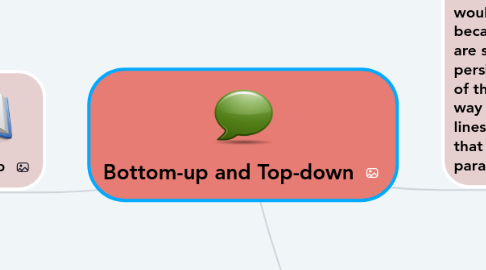Bottom-up and Top-down
by karina zaldaña

1. Bottom-up
1.1. refers to processing sensory information as it is coming in. In other words, if I flash a random picture on the screen, your eyes detect the features, your brain pieces it together, and you perceive a picture of an eagle. What you see is based only on the sensory information coming in. Bottom-up refers to the way it is built up from the smallest pieces of sensory information. (OpenPSYC, 2015)
1.1.1. It is defined as the physical perception of things, but only persisted as externally without going into details or relating them to others, does not seek logic or classification of what is persisted.
2. Top-down
2.1. on the other hand, refers to perception that is driven by cognition. Your brain applies what it knows and what it expects to perceive and fills in the blanks, so to speak. (OpenPSYC, 2015)
2.1.1. It is defined by taking small pieces and placing them in context or relating them to information already acquired.
3. An example in a handwritten paragraph, there is a word that cannot be understood well, this would be the case of bottom up because only meaningless lines are seen together (which is persistently persisted) in the case of the top down the brain seeks a way of ordering and coding the lines to form a meaningful word that gives meaning to the paragraph.
3.1. bottom up is characterized in simply perceiving forms and strokes of a word, drawing or object. For example, a book on a table, when we use the bottom up, our mind does not focus on the cognitive, but on the form of the book and not, what kind of book is it? What branch of science does it belong to? color, size etc.
3.2. Top-down processing of language happens when someone uses background information to predict the meaning of language they are going to listen to or read. Rather than relying first on the actual words or sounds (bottom up), they develop expectations about what they will hear or read, and confirm or reject these as they listen or read. Top-down processing is thought to be an effective way of processing language; it makes the most of what the person brings to the situation.
3.3. Example Asking learners to predict what a newspaper article might be about from the headline or first sentence will encourage them to use top-down processing on the article. In the classroom Learners can be encouraged to use both bottom-up and top-down strategies to help them understand a text. For example in a reading comprehension learners use their knowledge of the genre to predict what will be in the text (top-down), and their understanding of affixation to guess meaning (bottom-up).


